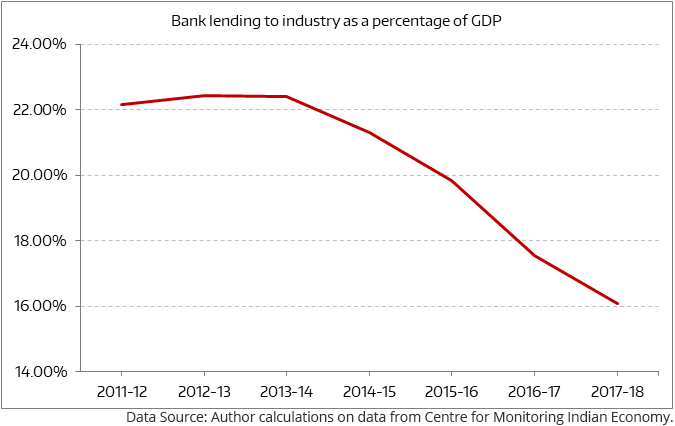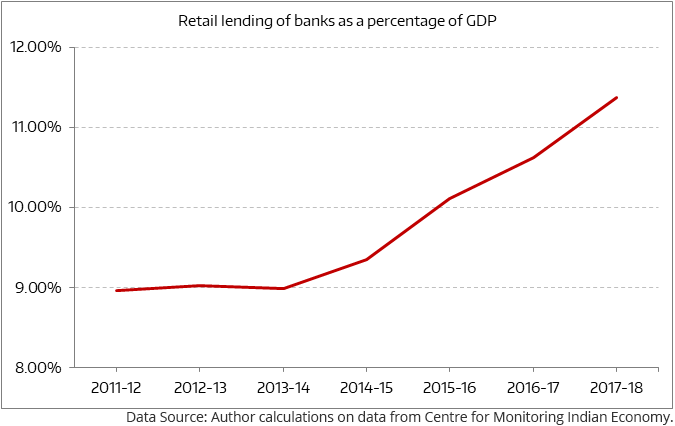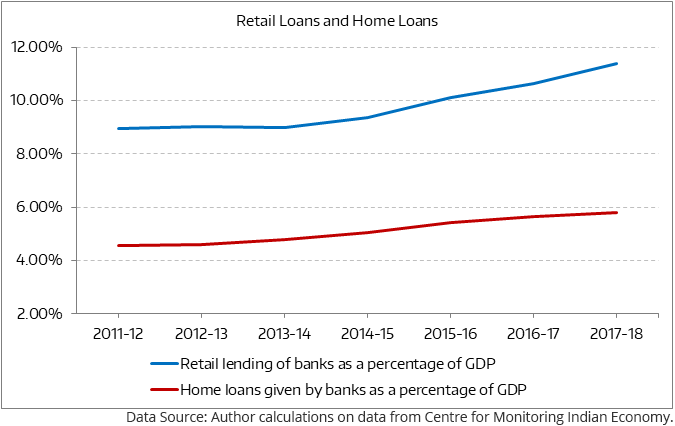
Indian banking is in a crisis. The bad loans of Indian banks have crossed Rs 10 lakh crore. In this scenario, it is but natural that the huge pile-up of bad loans, has brought about a change in the way, banks now lend. Bad loans are basically loans which have not been repaid for 90 days or more.
Take a look at Figure 1. It basically plots out the total lending carried out by Indian banks to industry, as a percentage of the gross domestic product (GDP) of India.
Figure 1:

Figure 1 tells us very clearly that the bank lending to industry as a proportion of the GDP has fallen. Now take a look at Figure 2, which basically plots out retail lending of banks (home loans, auto loans, credit cards outstanding, commercial vehicle loans, personal loans etc.), as a percentage of GDP, over the years.
Figure 2:

Figures 1 and 2, clearly tell us that the banks are not in the mood to lend to industry. The lending to industry fell from 22.18% of the GDP in 2011-12 to 16.09% of the GDP in 2017-18. In fact, this is for banks as a whole. If data for public sector banks total lending to industry as a whole was available in the public domain, the fall would have been much worse in Figure 1.
As we said earlier, banks are clearly in a mood to lend to retail. The overall retail loans of banks increased from around 8.96% of the GDP in 2011-12 to 11.38% of the GDP in 2017-18.
What is happening here? Nearly three-fourths of bad loans of banks have accumulated on defaults by the industrial sector. So, clearly they are not in the mood to lend to the sector. Over and above this, there are certain advantages in lending to the retail sector. It is easy to recover retail loans in case of a default. The same cannot be said in case of loans given to industry.
Home loans form more than half of the retail loans (take a look at Figure 3). The collateral in this case (the house for which the loan has been taken) is solid (unlike in case of lending to corporates). Also, because black money is a part of many real estate transactions in India, the margin of safety for banks on their home-loans is higher than other loans. Further, there is a huge social pressure as well on borrowers to not default on a home loan.
Figure 3:

Nevertheless, when such a huge jump in lending to a particular sector happens, there is bound to be a fall in the quality of lending. What does the data say?
The bad loans of the retail sector as on September 30, 2017, stood at 2.1%. It has been hovering around this figure for a while now. One reason for this low ratio is because State Bank of India, the country's largest bank as well as the country's largest public sector bank has a low bad loans ratio of 1.23%, when it comes to the lending to power sector.
This low retail bad loans ratio of the country's largest bank has basically ensured that the overall retail bad loans ratio is at a low of 2.1%.
The trouble with averages is that they hide the details. Take a look at Table 1, which has the details of the bad loans ratio when it comes to retail lending of many public sector banks.
Table 1:
| Name of the Bank | Retail NPA (in %) (as on March 31, 2018) | Retail NPA (in %) ( as on March 31, 2014) |
|---|---|---|
| Bank of Baroda | 2.40% | 1.96% |
| Bank of India | 2.57% | 0.67% |
| Union Bank of India | 2.11% | 2.03% |
| Central Bank of India | 4.44% | 3.39% |
| Indian Overseas Bank* | 3.25% | 2.40% |
| UCO Bank** | 7.73% | 2.29% |
| Bank of Maharashtra** | 4.91% | 1.70% |
Table 1 clearly tells us that retail bad loans of quite a few public sector banks have jumped over the last four years. While, this is not a crisis like situation at all (it's nothing in comparison to the bad loans situation of loans given to industry), it is a situation which needs to be recognised as a problem and tackled, and not allowed to grow into something big.
The trouble is that right now everybody is busy tackling the bad loans situation of loans given to industry. We sincerely hope that this 'new' situation is nipped in the bud and does not lead to the government having to keep bailing out the public sector banks using taxpayer money, in the years to come.
Also, a detailed analysis by the public sector banks and the government as the owner of these banks, is necessary, because we have access to only broad data in the public domain. This data does not tell which kind of retail loan is being defaulted on the most, if at all that is the case.
As the old cliche goes, prevention is better than cure.
Regards,

Vivek Kaul
Editor, Vivek Kaul's Diary

Vivek Kaul
Editor, Vivek Kaul's Diary
PS: For over 16 years, members of the exclusive Bombay Investing Society have received safe stock recommendations that generated double, even triple digit returns! This society is currently accepting new members. Click here to find out how you can join...
Vivek Kaul is the Editor of the Diary. He is the author of the Easy Money trilogy. The books were bestsellers on Amazon. His latest book is India's Big Government - The Intrusive State and How It is Hurting Us.
Disclaimer: The views mentioned above are of the author only. Data and charts, if used, in the article have been sourced from available information and have not been authenticated by any statutory authority. The author and Equitymaster do not claim it to be accurate nor accept any responsibility for the same. The views constitute only the opinions and do not constitute any guidelines or recommendation on any course of action to be followed by the reader. Please read the detailed Terms of Use of the web site.
No comments:
Post a Comment